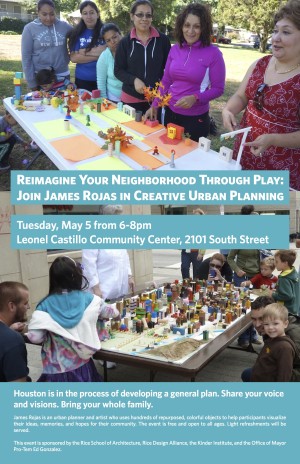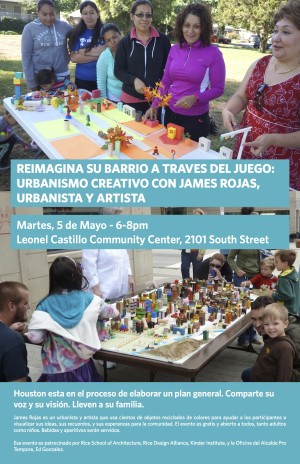Reimagina Su Barrio a Traves del Juego / Reimagine Your Neighborhood Through Play: Interview of James Rojas

Raj Mankad interviews James Rojas
On Tuesday May 5 at the Leonel Castillo Center, artist and urban planner James Rojas will lead a public workshop. Rojas uses hundreds of repurposed, colorful objects to help participants visualize their ideas, memories, and hopes for their community. The event is free and open to all ages. Light refreshments will be served. The event is sponsored by the Rice School of Architecture, Rice Design Alliance, the Kinder Institute, and the Office of Mayor Pro-Tem Ed Gonzalez.
In the interview below, Rojas talks about his background and methods with Raj Mankad, the editor of Cite: The Architecture + Design Review of Houston, which is based at Rice.
Raj Mankad: You have a degree in urban planning from MIT. How did you end up setting up play instead of working in a traditional urban planning office?

RM: Could you talk more about how most planners think and work?
JR: Planning is set up to be a scientific problem solving profession. Planners tend to think of the city as a problem not experience. Experience is about how your body connects to the city. I was in Brooklyn yesterday. On one side of the street were Brownstones with stoops and on the other were highrise public housing projects. The brownstones are an experience and the public housing, that’s a housing solution: we need to build a 100 housing units, quickly and cheaply. A solution to a problem. With row houses, we build these experiences and hopefully attract people to live in them. With problems, we deal with data. With experiences, we deal with sensory details. Planners deal with the world of data. They’re not really comfortable with the sensory characteristics of cities; it’s hard to measure that kind of quality.
Most cities were built because they felt good rather than though an abstract process of rules and regulations. Now we build cities with these rules. Places like L.A. were all built by planning not experience.
RM: But you love East L.A.? So the abstract process and regulations must have worked to some extent, right?

RM: When did you translate this research interest in your neighborhood into urban planning through play? Was there a eureka moment?
JR: I’ve been building cities since I was a two years old. The eureka moment? I figured out that by having people build with all these shapes and forms, you are actually capturing their experiences rather than data. It is data but from experiences. The materials help capture people’s experiences of the city. The city is a visual and spatial language. People know that intuitively.
RM: I want to know more about how you got started? When did the play begin? Was there a specific experience?
JR: After MIT, I started working in planning as a planner. Then I opened up an art gallery in LA about ten years ago. That was when I made the connection between art, planning, and play. Working with artists, you realize they look at the same space as planners, but they look at it from very different perspectives. I was fascinated by how arts is all about engagement. They engage the visual, the tactile. I put those pieces together. How could we as planners be like artists and engage people through their senses? There’s nothing logical about art. People respond to it with their senses. Artists get a better response than through data. People are not going to hang a spreadsheet in their house. They’ll hang a picture.
RM: When you come to Houston and hold the public workshop at the Leonel Castillo Center, how are you going to get people to participate?
JR: I will have people talk about themselves through their favorite childhood memory because that tells us who you are, where you came from, and what you value. Now the workshop is in their hands, not my hands. They learn about each other, share, create the bonding and empathy they need to plan together. I’ve done the workshop so many times, the group has this aha moment when they figure they were the same people when they were kids. They realize they share values. People are ready for the next step. They can plan because they trust each other.
RM: Houston is known for not having zoning and not having a general plan. The city is in the very early stages of developing a general plan. Does that change your approach?
JR: It should be great. People are people. People work, they have schools. L.A., New York, San Francisco. There are geographical differences but people will want the same things. Do you think Houston is a better city because it is not planned? Or is the city falling apart because it isn’t planned? Are there more problems? Or less?
RM: It’s a double-edged sword. There are certain opportunities. It can be easier for people to switch uses of certain buildings. It’s difficult for a community without substantial resources to meaningfully articulate their goals and be listened to. In a way, Houstonians are more empowered to take control and define their own destiny. We hit limits when some major collective undertaking is required. Communities with resources get things done. But not others…
JR: In New York City, for a 100 years it had no zoning. Madison Avenue was always changing. That’s the natural order of a city. It always changes. When you bring in zoning, there are artificial barriers. In Houston, it will be interesting.
In L.A., they have all this industrial land use zoning. When the city did a survey, half of it had housing and was mixed use. There had been variances. There are elaborate codes that nobody can read.
I tell people, your imagination is going to shape the city of the future. Some things people can do by themselves.
RM: What do you mean? What about forces that are too big for individual action to counter?
JR: We can talk about biking. Twenty years ago, nobody in the U.S. biked. Now there are bikers are everywhere. All traffic planning has been for cars. Now you have this big movement for biking. You can’t build bike lanes fast enough.
Or this idea of gentrification. San Francisco, D.C., Boston. They are so affluent now. When I was in graduate school in the ‘90s, the question was how can you save the city? Now you have Millennials moving to the city. In the ‘70s it was the suburbs. We didn’t predict this. Now there is massive displacement. A lot of people are being pushed out. It is a really different time.
The imagination shapes the city. How do young people imagine their lives? It’s not, here’s the suburban house we imagined for you. No, it’s Harlem. Latinos reshape their environment. It’s all through imagination. Imagination is a valuable force in how people are going to shape a city.
The workshops capture people’s imaginations. I don’t want to know what is out their now in the city, I want to know what’s in the participants minds. That’s going to shape the city. How do they project themselves 30 years from now, rather than looking at the current conditions. Maybe for the people who live there, it’s a different world right now. Most planning doesn’t go there.
For Houston, ask people how do you imagine Houston in 2025? From there, you start imagining the goals. Not everybody knows all the answers. You need to have a public process where everybody can be part of it. I am intrigued by this methodology. You bring in other situations and challenges. Frankly, it gives people more control over the process. I want people to self discover their own solutions to their own problems rather than me tell them the solution. I can tell people to bike and be healthy but they’ll do their own thing, right?
RM: You’ve done this everywhere from East L.A. to inner city Detroit to Harvard. Now that official city programs are bringing you in, does that change your outsider, bottom-up approach?
JR: I will be working with the Eugene, Oregon Parks and Recreation Department on how to get Latinos involved. I am working with cities little by little. It works out. It’s a method to have community-driven process. Anybody can do it. It is open ended. So there is nobody who can control the process. The city can’t tell you what your childhood memory is. This is a method to have a more open and inclusive process.
-
Luis Guajardo













